
THIS WEBSITE, THE BRIGHTON BRANCH OF A.S.L.E.&F.
HAS NOW BEEN MOVED TO A NEW SITE CALLED
IGNITING THE FLAMING OF UNITY
http://ignitingtheflameofunity.yolasite.com/1939.php
PLEASE CLICK ON THE IMAGE BELOW TO TRANSFER TO THIS NEW SITE
CLICK ON THE ABOVE IMAGE TO TAKE YOU
TO THE NEW UPDATED COMBINED AND WEBSITE
IGNITING THE FLAME OF UNITY WEBSITE
THIS WEBSITE COMBINES THE FOLLOWING WEBSITES
THE BRIGHTON A.S.L.E.&F., THE BRIGHTON MOTIVE POWER DEPOTS
& THE SUSSEX MOTIVE POWER WEBSITES
WHICH EXPLAINS THE EVOLUTION OF THE FOOTPLATE GRADES AND THE HISTORY OF THEIR TRADE UNIONS AND THE STRUGGLES TO IMPROVE THEIR WORKING LIVES
THE WAR YEARS
No. 1 BRANCH SECRETARIES
WILLIAM C. PLAINE 1937 - 1941
(Footplate Seniority 29.04.1901)
& A. E. FRENCH 1942 - 1950
(Footplate Seniority 31.03.1919)
No. 2 BRANCH SECRETARIES
H. BEALL 1936 -1942
(Footplate Seniority 12.07.1897)
& C. BATCHELOR 1943 - 1949
(Footplate Seniority 21.04.1913)
First they came for the communists, and I didn't speak out because I wasn't a communist.
Then they came for the socialists, and I didn't speak out because I wasn't a socialist.
Then they came for the trade unionists, and I didn't speak out because I wasn't a trade unionist.
Then they came for me, and there was no one left to speak for me.
Martin Niemöller 1892–1984
BRITAIN'S FORGOTTEN ARMY
The historians have recorded very little of the importance that the railway's played during the war. This page, in the coming
months, will try to explain the important role played by the enginemen. Although being an Enginemen was classed as a
“Reserved Occupation” and as such they could not be conscripted into the armed forces they were all expected to enter the
Home Guard so not only were they working very long hours at work they were then expected to spend many more hours
guarding their Depots and Sidings. The enginemen were putting their own lives at risk, whilst carrying out their work and
keeping the country moving, whilst hostilities where going on all around them. Some engine men paid the ultimate price, as
they come under attack from enemy aircraft
The politicians promised all of Britain’s railwaymen and woman that after the war was over they would be rewarded for their commitments for keeping the trains moving around the country. The railwaymen and women were going to go beyond their normal expectations and at times too confronted with some of the most difficult circumstances that they would never expect to endure under normal circumstances. It was not uncommon for Enginemen to be on Duty for 24 hours only being relieved when they had run out of food and water!!.
During the Second World War, holidaymakers using the lines to the Channel ports and the West Country were replaced by troops, especially with the threat of a German invasion of the south coast in 1940. Before the hostilities began, 75% of traffic on the Southern Railway was passenger, compared with 25% freight; during the war roughly the same number of passengers was carried, but freight grew to massive 60% of total traffic. A desperate shortage of freight locomotives was remedied by C.M.E. Oliver Bulleid with the introduction of the C1 “Austerity” Class Locomotive on the Southern Railway while the volume of military freight and soldiers moved by a primarily commuter and holidaymaker carrying railway was a breath-taking feat.
The British evacuation from France has been extensively documented but the historians have done less than justice to its sequel, which involved another 'evacuation'. This one was by land on our side of the Channel. All those troops had to be disembarked at various ports along the Kent and Sussex Coast from where they would be moved by train to place all over England. The railway was still by far the predominate system of land transport; and the German Air Force, with a few well-placed attacks, could have served our Southern railway links to the ports and caused total disruption to this second evacuation. It is anybody’s guess what would have after that, fortunately this did not happen.
In the Spring of 1940, the Germans had conquered France in a six week blitz offensive. This left the British Expeditionary Force with its back to the sea, trapped on the beaches of Dunkirk. It is now a matter of history that most of our beleaguered army was saved: as armada of rescue craft (including ‘the little ships’) swarmed across the English Channel to pluck our soldiers from the beaches of Northern France. This was Operation ‘Dynamo’ which took place between the 27th May to the 6th June 1940, ‘the miracle of Dunkirk’, which left Britain to fight another day.
The railway companies had only a few days to prepare and to co-ordinate for this huge operation and at any moment those days might have dwindled to hours, to co-ordinate all their Locomotives, rolling-stock and train crews and had to produced virtually ‘out of a hat’.
The Dunkirk trains would require immaculate organising and the trains had to be brought together to be in the right place at the right time – and then keeping them moving along hastily – improvised paths.
Nobody could foresee just how soon the evacuation would begin – it was imminent all the time. Moreover, it was impossible to predict how many soldiers would be rescued from Dunkirk and how many would be left behind. The only course was to plan and pray for the maximum number to be brought home; and on this basis it was estimated that 150 trains would be required. It was envisaged by the War Office that the
British Expeditionary Force – or whatever was left of it – would be disembarked at eight Southern coastal ports: Margate, Ramsgate, Dover, Folkestone,
Hastings, Eastbourne, Newhaven and Brighton. From these places the movement of rail would begin and the travellers themselves would be no ordinary passengers: they would be dishevelled survivors who had escaped from Hell, and many of them would be wounded.
The evacuation trains were eventually seen on all four of Britain’s main-line railways, heading for various destinations. But they all had to start from a handful of stations along the South Coast; and before doing so they, they had to enter this congested area as empty coaching stock. Hence it was on the South Coast that the drama was enacted out in its entirety.
The movement started at dawn on May 27th 1940, and it took 186 trains and not 150 trains as planned for. The trains never stopped for nine and half days with the enginemen working continuously throughout. The evacuation trains moved 323,000 men away from the ports and across the country to safety. The enginemen on trains were coming into the stations, were dazed with weariness. It didn't make it easier for the railwaymen and women, that the ports weren’t quite the same as the Railway had planned for. Of course, the railway workers didn’t know anything about it at first, until the first train had arrived in the station, before they realised what was happening.
A.S.L.E.F. along with the NUR applied for an increase in wages for Railway staff in November 1940. In May 1941 Enginemen were awarded an extra 4s per Week taking the War Advance to 11s per week
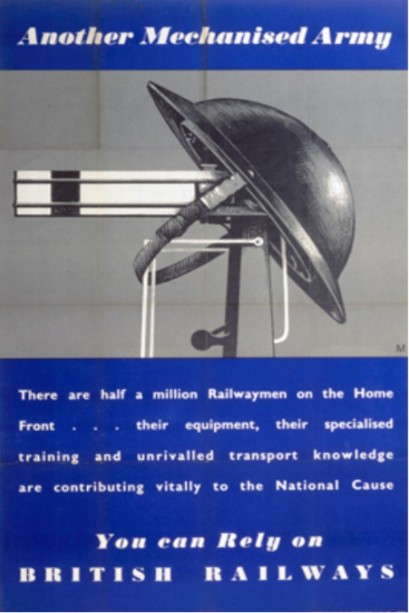
SIX SOUTHERN SARGENTS
IN THE WESTERN DESERT 1942
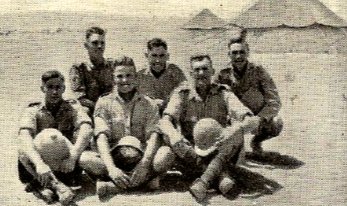 Back Row L~R: B.P. Pope, H. Bowers (Nine Elms), & F. Harding (Salisbury). Front Row L~R S. Reeves (Brighton Driver), H. kent (Salisbury) & H. Upton (Eastbourne Driver). They all volunteered for the Military Police at the outbreak of the war and are photographed somewhere inthe Middle East. Southern Railway Magazine Sept/Oct 1942 |
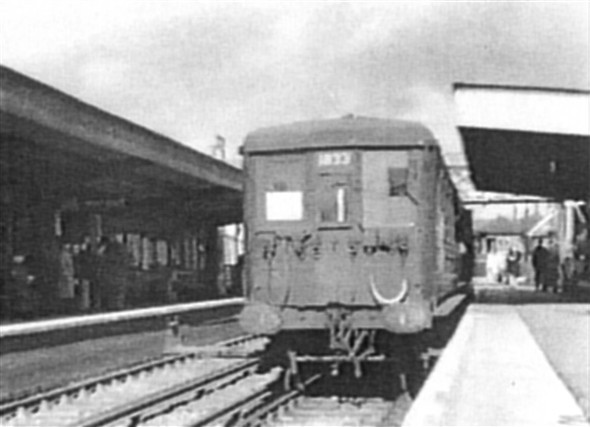
Richard Beckett Collection
The train above has protective mesh on the Motorman’s cab
windows with small cut out area to enable the Motorman to see
out off, the mesh was to prevent splintering in case of bomb
damage.
The evacuation trains were eventually seen on all four of Britain’s main-line railways, heading for various destinations. But they all had to start from a handful of stations along the South Coast; and before doing so they, they had to enter this congested area as empty coaching stock. Hence it was on the South Coast that the drama was enacted out in its entirety.
The movement started at dawn on May 27th 1940, and it took 186 trains and not 150 trains as planned for. The trains never stopped for nine and half days with the enginemen working continuously throughout. The evacuation trains moved 323,000 men away from the ports and across the country to safety. The enginemen on trains were coming into the stations, were dazed with weariness. It didn't make it easier for the railwaymen and women, that the ports weren’t quite the same as the Railway had planned for. Of course, the railway workers didn’t know anything about it at first, until the first train had arrived in the station, before they realised what was happening.
A.S.L.E.F. along with the NUR applied for an increase in wages for Railway staff in November 1940. In May 1941 Enginemen were awarded an extra 4s per Week taking the War Advance to 11s per week
The engine cab where Enginemen almost lived day and night, were shrouded from the cab roof to tender-end by the
obliterating anti glare sheet, which not only trapped the revealing glare from the engine's fireboxes, but kept the heat in as
well. Enginemen would end up suffering from heat rash, as if they had just emerged from a baker's oven.
There were instructions given to Enginemen at the beginning of the war - to seek cover when air-raid warning came along -
was not, in practice, a success. To stop the railways intermittently simply could not be done, and so it soon became general to
treat that red warning as nothing more or less than indication to be on alert. Even the tiniest blink of light from the engines
was blanked out as the Enginemen crept through a blackness which almost be felt. Enginemen were also instructed how to
immobilise their engines in the event of enemy invasion. The people who issued this instruction, would have been surprised if
they had if they heard some of the ribald remarks with which it was greeted, for te officials of the company did not realise just
what it meant to a driver and fireman to be told to sabotage their engines, they had regarded for as sacrosanct
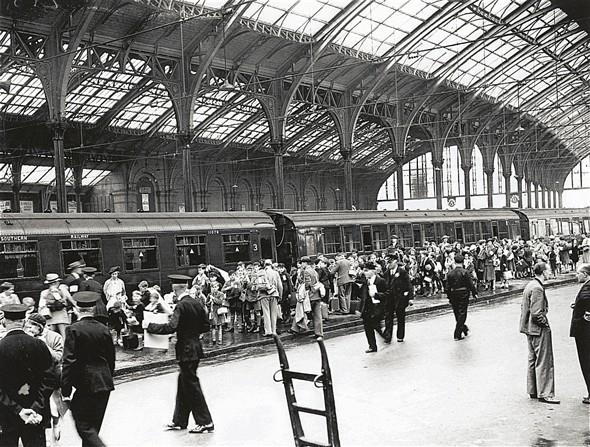
PHOTOGRAPHER UNKNOWN
Evacuees arriving at Brighton in late 1939
On Wednesday 3rd July, 1940 the 17.37 train from Seaford was machine - gunned between Bishopstone to Tide Mills. The driver, Charles Pattenden was killed but th passengers ducked down and tried to under their seats. The aircraft then dropped six bombs nearby which shattered the windows of the carriages and injured several passengers. Mrs May Terrrill of Newhaven who said afterwards, “It happened so quickly. All the windows were smashed and had lots of splinters of in our hair. My son Ronald (later to become a driver at Newhaven & Brighton) a babe in arms had a cut neat one eye and the back of my coat was marked as if it had been scorched."
TUNBRIDGE WELLS BRANCH 1940
Driver C. Pattenden of Tunbridge Wells Branch was killed when his train was bombed and machine gunned by a German plane: he was the first of many which went to prove the "lines behind the lines" were not so very far in the rear.
Taken from
“The Lighted Flame”
LOCOMOTIVE JOURNAL
SEPTEMBER 1941
FROM THE GENERAL SECRETARY’S PEN
FIRE-WATCHING
Several enquiries are being made by member referring to the Fire-watching Order No. 69. It may not be generally known that
the Minster of Transport, who is the appropriate authority scheduled by the Order, has now this Order compulsory so far as
railways are concerned.
This means that fire-watching will take place at all points on the railways systems where it is considered to be necessary.
A rota of duties will, therefore, be drawn up after consultation with the representatives of the staff and exhibited for all
concerned.
Our Local Departmental Committee Representatives should follow the advice set out in circular letters issued from Head
Office under dates of February, 7, March, 6, and May, 20.
It is essential that the discussion with the representatives of the staff should take place prior to Fire-watching duties being
rostered.
In the meantime, we are seeking a meeting with the Minister of Transport in order to submit a number of points upon which
clarity is needed and where amendment appears to be necessary.
A.S.L.E.F. along with the NUR applied for an increase in wages for Railway staff in November 1940. In May 1941 Enginemen
were awarded an extra 4s per Week taking the War Advance to 11s per week. Serious exception was taken by the Enginemen
when an official Order on 'Fire-watching', which seemed to take no cognisance of our the Enginemen's very awkward of duty
or the irregular nature of the turns they worked, to say nothing of the very long hours they were called upon to perform
without any warning. When called upon to work these long hours without any provision being made to supply them with any
food.
When the threat of invasion had
receded, the Southern Railway
became the marshalling area for
troops preparing to invade
Normandy in Operation
‘Overlord’, and once again the
railways played its part by
providing a link in the logistics
chain. This came at a cost, as the
Southern Railway's location in
and around London and the
Channel ports meant that it was
subjected to heavy bombing,
whilst permanent way,
locomotive, carriage and wagon
maintenance was deferred until
peacetime.
Due to the continual manpower
shortage the war was causing in
1942 A.S.L.E.F. relaxed the
agreement regarding Enginemen
retiring upon reaching 65 and as
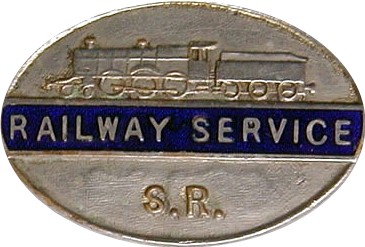
PHOTOGRAPHER UNKNOWN
World War II Service exemption badge, 'S.R.'
(Southern Railway)
During the Second World War Railway Footplate staff was once again given “protected
occupations” by the war office.
such many Enginemen continued to work very long hours helping the War effort above the age of 65. Also boys of 16 were
promoted to Firemen not just as cleaners. Their positions as cleaners having being taken over by women for the first time.
In June 1942 the War Advance was increased by 5s per week although this did not cover the increase in the cost of living the
War was causing. In April 1943 this was raised again by 4s 6d.
The sheer cold courage of Enginemen throughout the country, during the the Second World War, a place of pride in the ranks
of those civilians who helped this country in her darkest hour, went unrewarded.
After the cessation of hostilities A.S.L.E.F. presented to the Railway Executive Committee a claim for a substantial increase of
wages and improvements to terms and conditions these were Maximum working week of 40 hour, A National Pension Scheme
for Enginemen, Granting of a Fortnights paid Holiday, Enhanced Sunday Rate of Pay, Payment for Sick Leave and a
Universal Eyesight Test Enginemen did not receive any of these demands until 1948 after the Railways had been Nationalised
by the Labour Government.
It would take another six months of hard negotiations by A.S.L.E.F. before its members were given a wage increase, whichThe railwaymen and women of Britain have become the forgotten army, as they played a major part in helping to defeat the
Germans whilst remaining on British soil.
WOMEN ENGINE CLEANERS
CURTSEY OF TED JANES
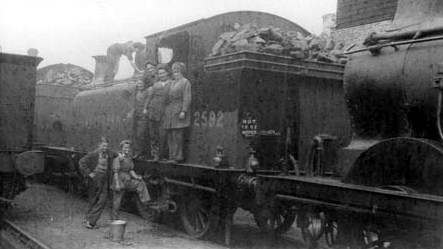
RALPH STENT COLLECTION
BRIGHTON MUSEM
Women played a very important role in the war. There was a Signalwoman at Southwick, and the giant crane in Lower Yard
was operated by Ernie Brown's sister, there were also a lot of female guards.
THE USE OF KEMP TOWN TUNNEL DURING THE WAR YEARS
BY TED JANES
During the War three complete 12 car sets used to be berthed in Kemp Town Tunnel to protect against possible bombing. They
were the Mainline stock (which disappeared with the introduction of Cigs & Bigs) and weighed about 600 ton each 12 car set.
After the evening rush hour they would leave Kemp Town Junction and freewheel into the tunnel as there was no juice and
berth for the night.
About 6 a.m. we would go light engine to the tunnel and couple up to the first 12 car, we used to have an E4 Radial Tank and it
would take ages with the Westinghouse pump thumping away before we had enough air to pull the train out of the tunnel as
far as the Cox’s Pill factory, from where we could see the junction signal, if you came closer to the junction than Cox’s, it was
hard work trying to move the train on the incline and in wet weather you would have no chance.
When the signal cleared we would pull the train almost into London Road station then propel it back clear of the junction so
we could go down for the next lot while the train went into Brighton for a London service. This was repeated until all three
trains had been hauled out.
Although Kemp Town Tunnel had no vents it cleared from smoke very quickly as it is on an incline all the way.
During the Second World War the Lancing Carriage Works was kept busy repairing bomb damaged carriages and wagons
and converting carriages to mobile hospitals to support the army during the D-Day invasion. The works were also involved in
constructing tail planes for gliders for the invasion.
Southern Railway Magazine article Jan - Feb 1942
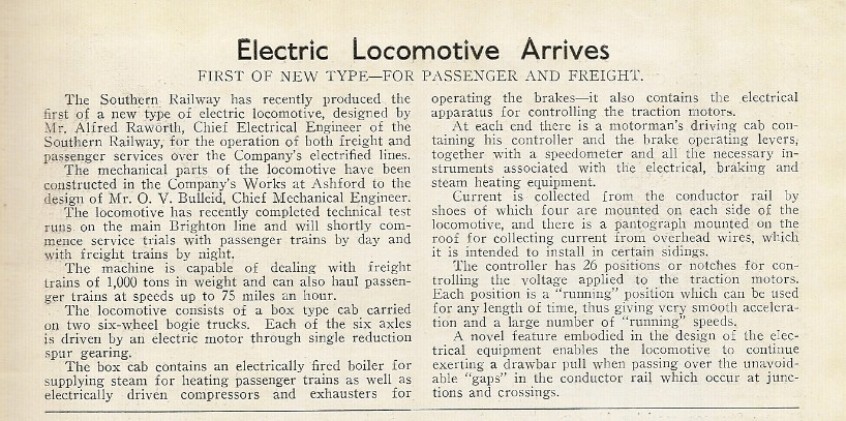
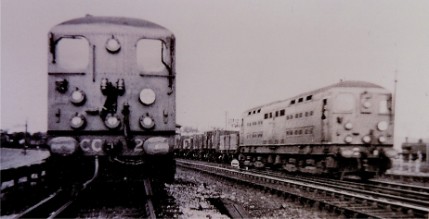
PHOTOGRAPHER UNKNOWN
Above
Southern Railway's all electric locomotives CC1 & CC2 seen shortly after
entering service at Three Bridges on the Horsham branch.
Externally, it was clear the cab design owed a
lot to Southern experience with the 2 HAL
multiple unit design. It has even been
suggested that (in true Southern tradition) this
was because the jigs for the welded cabs
already existed and thus made for speedy and
cheap construction. At the outbreak of war in
1939, most construction projects were put on
hold in favour of the war effort. Construction
of CC1 and CC2 was exempted from this
because of promised savings in labour and fuel
over steam locomotives. Construction was not
smooth however and was brought to a halt
several times due to shortage of resource.
After nationalisation in 1948, British Railway renumbered them 20001 and 20002 respectively. Also a third member of the
class (20003 from new) was built at Brighton. Although counted as the same class, 20003 was markedly different externally to
its two earlier sisters being 2 inches longer with flat 4 SUB like cab ends. Again a suspected economy drive and arguably
simpler (and therefore cheaper) design than the earlier two. Equipment changes also added 5 tons to the earlier 100 ton
design.
MANNING OF ELECTRIC LOCOMOTIVE CC1
A.S.L.E.F.’s 1942 A.A.D. RESOLUTION
Interest was aroused by, and discussion was heated on, an Electric Engine put into traffic by the Southern Railway and known
as the CC1. The long discussion by the delegates centred on the fact that the Southern Railway proposed to work this Engine
with 1 man in charge. There was tremendous opposition to this on all counts as we considered it a direct violation of the safety
code to have a single person in charge of such a machine on the head of passenger trains. So serious was the view the
Delegates took of this matter that the Executive Committee received instructions that if the Southern Railway carried out their
intention of manning the CC1 with 1 man an immediate strike should be called. It only remains to be said that this drastic
threat was never put into operation since the Southern Railway agreed to work the CC1 on freight traffic under the charge of 2
men after representation by our society.
Taken from “The Lighted Flame”
ses where the Locomotive is placed in service, we could only agree that it should be manned by two men in the recognised Line of Promotion, i.e. two Motormen, or a Motorman and ASOssistant Motorma
LOCOMOTIVE JOURNAL
SOUTHERN RAILWAY ELECTRIC ENGINE C.C.1.
Arissing from the policy which has been adopted in connection with the working of this engine, an agreement has now been
reached with the representatives of the Southern Railway Company, by which this engine will be confined to the working of
unbraked frieght trains, and it will by manned by two men, one a Motorman, and another an Assistant Motorman, both of
whom will be in the line of promotion. the agreement reached precludes this or any similar type of engine from being worked
with one man only, and will remain in operation during the period of hostilities.
Below a reproduction of a circular from head office regarding the manning of the Southern Railway's Electric Locomotive
ASSOCIATED SOCIETY OF
LOCOMOTIVE ENGINEERS & FIREMEN
Ref no. 43/1945
25th August 1945
To Branches
Southern Railway
MANNING OF ELECTRIC LOCOMOTIVE - SOUTHERN RAILWAY
As you are no doubt aware a number of complaints have been received from time to time regarding
the manning of the Electric Locomotive on the Southern Railway, and the position has been raised
in discussion with the Company.
The Executive Committee have recently given further consideration to the subject, and arising
therefrom the Company having been informed that in all cases where the locomotive is place in
service, we could only agree that it should be manned by two men in the recognised Line of
Promotion, i.e. two Motormen, or a Motorman and Assisting Motorman.
In order to safeguard against future eventualities I shall be glad if you will advise me
immediately there in any departure from this working, and in this event I shall be glad if you
will send the fullest possible information to this Head office.
Thanking you to bring this to the notice of your members.
On behalf of the Executive Committee,
Yours fraternally,
W. P. Allen
General Secretary
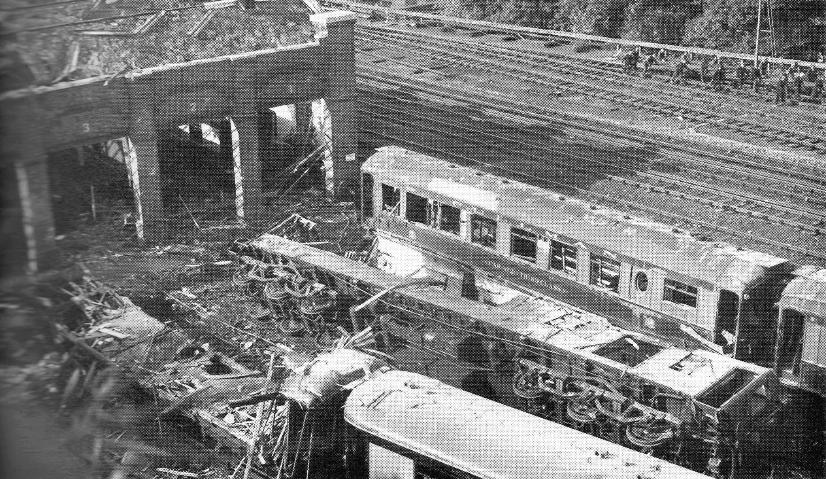
PHOTOGRAPHER UNKNOWN
Pullman Shops after air raid
LOCOMOTIVE JOURNAL
MARCH 1943
BRIGHTON NO.1 BRANCH
The L.D.C. elections have taken place and we have returned to our own A.S.L.E. and F. candidates. On the Sunday previous to the election we had a visit from our E.C. member, Bro. H. Bidwell, Bro. Jukes, Sectional Council Secretary and our Sectional Council member, Bro. J. Godfrey. Although our two meetings were not well attended they were interesting, and the members present will have made it well known. Now members, we have a new Secretary and a new L.D.C., so come to the branch and help build up a 100 per cent. membership, trade union and political. After the war we want a new world with new and better conditions, fortnight holiday with pay, etc. Members, have you ever considered the payments you make to your trade union and the benefits you receive for such a small sum? Come to the branch and discuss with a view to build up a good fighting fund for use after the war.
The Southern Railway's 2nd World War memorial at Brighton station
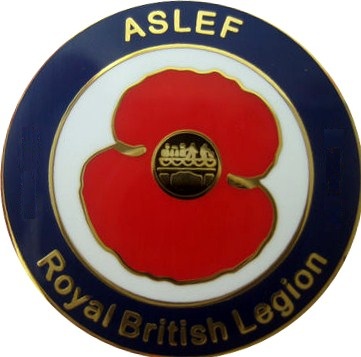
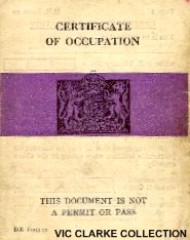
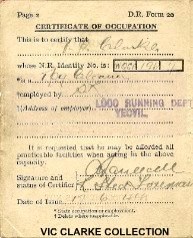
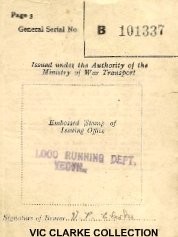
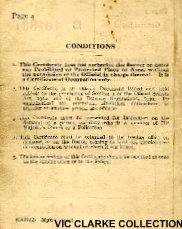
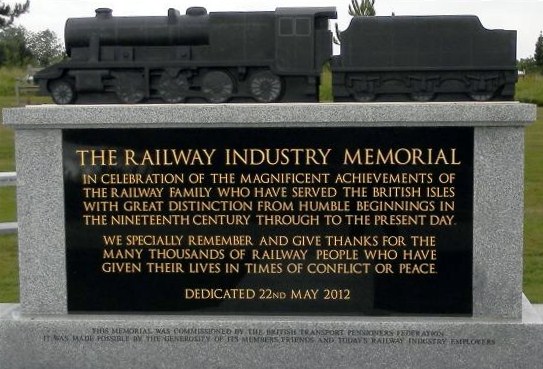
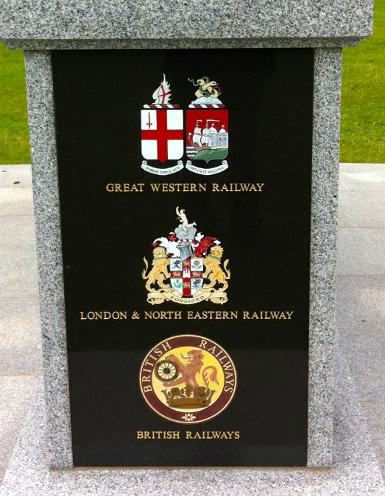
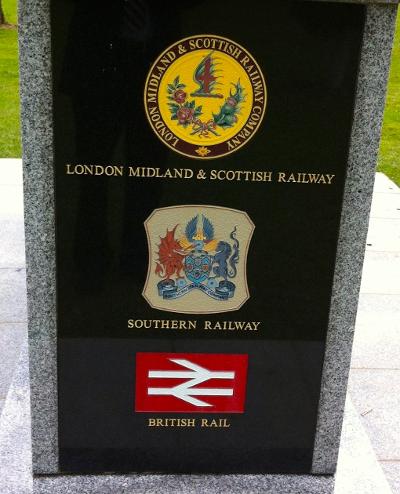
THE BRIGHTON BRANCH OF A.S.L.E.&F. WEBSITE.
HAS NOW BEEN MOVED TO A NEW SITE CALLED
IGNITING THE FLAMING OF UNITY
https://ignitingtheflameofunity.yolasite.com/
PLEASE CLICK ON THE IMAGE BELOW
TO TRANSFER TO THIS NEW SITE
CLICK ON THE ABOVE IMAGE TO TAKE YOU
TO THE NEW UPDATED COMBINED AND WEBSITE
IGNITING THE FLAME OF UNITY WEBSITE
https://ignitingtheflameofunity.yolasite.com/
THIS WEBSITE COMBINES THE FOLLOWING WEBSITES
THE BRIGHTON A.S.L.E.&F., THE BRIGHTON MOTIVE POWER DEPOTS
& THE SUSSEX MOTIVE POWER WEBSITES
WHICH EXPLAINS THE EVOLUTION OF THE FOOTPLATE GRADES AND THE
HISTORY OF THEIR TRADE UNIONS AND THE STRUGGLES TO IMPROVE
THEIR WORKING LIVES
CLICK ON THE ABOVE IMAGE TO TAKE YOU
TO THE NEW UPDATED COMBINED AND WEBSITE
IGNITING THE FLAME OF UNITY WEBSITE
https://ignitingtheflameofunity.yolasite.com/
THIS WEBSITE COMBINES THE FOLLOWING WEBSITES
THE BRIGHTON A.S.L.E.&F., THE BRIGHTON MOTIVE POWER DEPOTS
& THE SUSSEX MOTIVE POWER WEBSITES
WHICH EXPLAINS THE EVOLUTION OF THE FOOTPLATE GRADES AND THE
HISTORY OF THEIR TRADE UNIONS AND THE STRUGGLES TO IMPROVE
THEIR WORKING LIVES
DAVID KNOTT COLLECTION
The National Memorial Arboretum at Alrewas (near Lichfield) in East Staffordshire site of the national
remembrance for railwaymen & women
